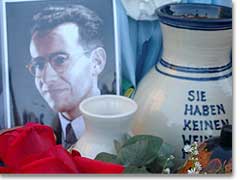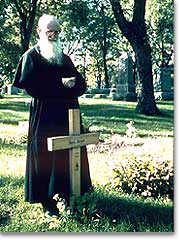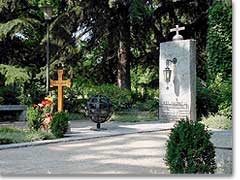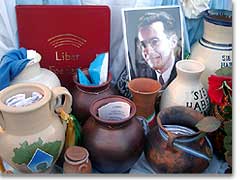 |
|
Mario Hiriart – modelo de la santidad laical Mario Hiriart – model of laical santity Mario Hiriart – Modell laikaler Heiligkeit |
|
 |
|
Los postulatores de las causas en Roma: Hna Thomasine Treese (Hna Emilie), P. Joachim Schmiedl (José Engling), P. Angel Strada (Mario Hiriart – y ojala pronto el P. José Kentenich) The postulators of the „causes“ already in Rome: Sr. Thomasine Treese (Sr. Emilie), Fr. Joachim Schmiedl (Joseph Engling), Fr. Angel Strada (Mario Hiriart, and hopefully soon Fr. Kentenich) Die Postulatoren der “Causae”, die schon in Rom sind: Schw. Thomasine Treese (Schw Emilie), P. Joachim Schmiedl (Josef Engling), P. Angel Strada (Mario Hiriart, und hoffentlich bald P. Kentenich) |
|
 |
|
Compañeros de Mario Hiriart: Guillermo Tagle, Germano Arendes Companions of Mario Hiriart: Guillermo Tagle, Hermann Arendes Weggefährten von Mario Hiriart: Guillermo Tagle, Hermann Arendes |
|
 |
|
P. José Kentenich en la tumba de Mario Hiriart en Milwaukee Fr. Joseph Kentenich at the tomb of Mario Hiriart in Milwaukee P. Josef Kentenich am Grab von Mario Hiriart in Milwaukee |
|
 |
|
Tumba de Mario Hiriart en Bellavista, Chile Tomb of Mario Hiriart in Bellavista, Chile Grab von Mario Hiriart in Bellavista, Chile |
|
 |
|
8 de septiembre, en la bendición del Santuario de Belmonte: rosas de Mario para su Reina September 8, day of the blessing of the Shrine in Belmonte: roses from Mario, for his Queen 8. September, Einweihung des Heiligtums in Belmonte: Rosen von Mario für seine Königin Fotos: Springer © 2005 |
|
|
SCHOENSTATT, isp / mkf. "What influence does God have on the work, fun, sports, reading, and way of singing, traveling, dancing or the hand-washing of a lay person in the 20th Century?" The answer to this question, asked by a young Chilean engineer in 1957, who is determined to change the common answers to this question, is "a big one." And this in the years before the Second Vatican Council, in which the Church discovered – after centuries – that lay people have a mission in the order of the world, and that their most specific original task is to permeate all the areas of life with Christ’s grace. For lay people of the 20th Century – many of whom are still searching for their mission in life in a religious vocation only, instead of in the sanctification of the world, this young Chilean: Mario Hiriart, is a pioneer yet to be discovered.
On October 5, 2004, Father Angel Strada, who since early January (2005) is the Vicar of the General Superior for the Schoenstatt Fathers, was named the postulator to continue the process of Mario Hiriart. Numerous teams and a central secretariat in Schoenstatt will support this work in the respective countries. "I feel continuously inspired by the spirituality of this man", says Monsignor Dr. Peter Wolf, Director of the Secular Institute for Diocesan Priests. "For me, it was a great pleasure that the documentation of his process was submitted to Rome on the same day as the Dedication of the Shrine in Belmont. I consider it the strongest sign of that day."
Even now, forty years after his death, Mario Hiriart can be considered a pioneer in his vision of the lay person’s vocation, the shaping of the world, and the spirituality of a professional life. And more and more people begin to take an interest in him. At the University of Coblenza, Germany, Mr. Hermann M. Arendes, of the Institute of the Brothers of Mary of Schoenstatt, directed a conference about Mario Hiriart as a perfect example of the lay person’s sanctity. This took place during a theological seminar in December of 2004. In Chile, his homeland, the Male Youth of Schoenstatt organized a conference about Mario Hiriart during a National Camp, in which 850 youth participated. Several workshops about Mario Hiriart, in the course of the year 2004, were held at the house of the Brothers of Mary in Bellavista and presented Mario Hiriart’s way of life as the school for life and guidance for young people; the workshops were all very well attended. Many people visited the meeting room, where through images and sound, as well as through selected texts from Mario Hiriart, one is able to get to know more about this person and his life.
Faith and everyday life: "two different languages, unharmonious"
"In the life of the modern lay person, even of the one who sincerely considers himself Catholic, the religious aspects rarely consist in more than going to mass on Sunday, some communion more or less frequent, and one or two merciful acts, preferably, of social help", wrote Mario Hiriart in 1957. "But, what influence does God have on the work, fun, sports, reading, and way of singing, traveling, dancing or hand-washing of a lay person in the 20th Century?"
"For some, as for Nietzsche, the old God has died. For the immense majority, that poor old God is alive, but sent apart to some beautiful corner in heaven, with all the activities with which modern man has no relation. This is where the last root of this total decentralization of the life of the modern lay person lays; the harmony between nature and grace has been broken due to a principle within it. They are different languages, unharmonious, life in two enormously distant planes that will never meet. If harmony is broken, the world today lives outside its center".
Mario did not just stay as a general diagnostician, but he sincerely, as a starting point, began to struggle to reunite both worlds within himself. "Working with so many problems, with so many naturalistic people, easily crushes one’s ideals. I could very easily forget that God’s calling is not in the first place a calling to be a magnificent professor or a good model for the students, nor an excellent professional: it is, over all, a calling to be saintly… But I should not forget that it is a calling to sanctity appropriate to the times we live in, to the state of life, to the vocation of being a lay person… Looked at this way, it is easy to find the organic union with the problem of being a good professional, a good professor, etc." He wrote this on August 12, 1960.
"A Copernicus turn: from selfishness to filiality".
"Slowly, Mario discovered the way to sanctity," says Amelia Peirone, member of the "Mario Hiriart Foundation" and of the team that works for the canonization process. "He did it while he was opening his inner self to God. He had ethical values, but it was only in his mature youth when he discovered the need and the beauty of living his live as an answer of love to God’s love, knowing that He always loved and gave Himself first. All of this was neatly done through a personal journey, in the covenant of love with Mary. In her he began to discover all the secrets of a life in God, with Him and for Him. Once he discovered this in his life, all other horizons were broadened: work, love, fraternity, profession, daily common life, prayer, suffering, giving of oneself, death. By being with Mary so much, and seeing at her as a transparency of God, his life made a Copernicus turn, as he says, from the selfishness to the filial spirit. It was a vital change of attitude that consisted in making the center of his life not himself, the ‘I’, but the ‘relationship’ with another, with God, as Mary did. This immediately brought him inner freedom, the joy and need to give it all, even himself, even his own life. All this translated into an insatiable yearning to be saintly, to give God the reigns of his life, to be a transparent chalice, according to his own words. In other words, to let God be everything in him – in Mario – and through him – through Mario – to let everything go back to God in a filial way, the entire person, his work, the entire creation, even each minute of daily common life".
"Excess work can not justify what happened, it can only explain it"
Here is a young man on a journey "to the honors the altar", that has struggled with excess work and stress, as many professionals do. He had lost contact with God in his daily life and was not to be conformed to that. "It has been a while since I had such a long period of forgetting the spiritual life during the day as much as these last few days, without a doubt it’s because of excess work and worries, but that can not justify what happened, it can only explain it. I have not had the inner attitude of becoming instinctive or turning towards God and offering Him this work or those worries that force me to keep my mind away from Him. Due to my inner disunion with God during the day, I have to create a new true habit of easily and spontaneously linking to the supernatural world, and this is very important, through what is my own. I will offer my Mother everything I do during the day so she can dispose of it as a contribution to her capital of grace in three very precise opportunities: the morning prayer, the Angelus at noon, and my evening prayers;
and I will do this as a chalice that is raised to God in the hands of man. The priest offers our nature so that God blesses it and make it precious." He wrote this on June 13, 1954.
And on June 11, 1959 he wrote what really matters, "It is not a simple ‘doing-too-many-things’ but doing them well because I do them in the presence of God, for his glory and as an offering to Him. This offering is the center of everything. If I have a good class simply because my students have a right to it, it’s an act with only ethical value; if I do it extraordinarily well because I know that is what God wants of me, and before I start my class I offer it to God, asking him that it be effectuve for his glory, and that through any detail that may escape me He might bring the boys closer to him, and if at the end of class I offer it again to Him, whether it was a success or a failure, then everything becomes an act of union with God, a beginning of an organic contemplation of God in daily life. In this way, a day’s work can become a silent, but uninterrupted and effective prayer. Nazareth was for you a constant doing everything with Him, as an expression of love. My Mother, help me also live God’s presence within me and around me, and all my actions of the day will be a silent but real contemplation and union with Him in love".
"Beat my unconcern with my work in the office"
"In the first place, I think I have an immediate and inevitable battlefield: rebuild my attention to my work", writes Mario Hiriart in his diary in 1955, and he describes his struggle to work efficiently, conscientiously and with attention. "I notice a strong tendency to place little interest in my work, to worry internally about many other things and still shirk exteriorly from it. Everything clearly indicates that I am not fulfilling perfectly my fundamental state of being: the distractions on the street and the dealings with the secretaries at the office; regarding the second item, I will try from now on, and as a norm, to be much more careful, treat them with respect and demand the same from them: this, at the same time, will help me be more efficient at work. To fight my unconcern with my office work, I will have to fight to maintain the maximum attention and interest possible in it; to make it more concrete: each time I note a tendency to get distracted during office hours, I will take out the picture of the Mother Thrice Admirable (MTA) from my billfold and I will take that moment to ask her for help."
The text and interviews with Amelia Peirone were taken from the "Mario Hiriart" Memo
The memo, writings and videos, CD and other brief reports can be obtained from: mario.sekretariat@schoenstatt.net, or by phone (at Schoenstatt) (0261) 65080 or (0261) 640980. More information at: www.schoenstatt.net